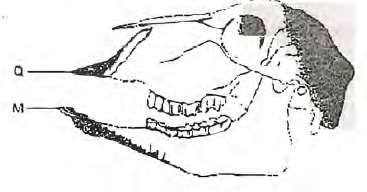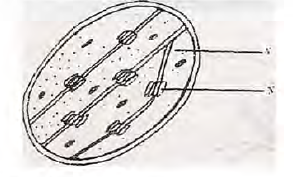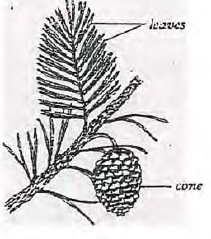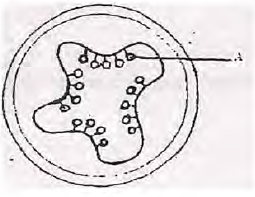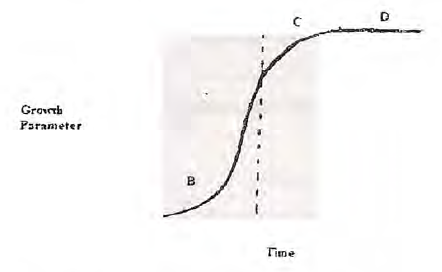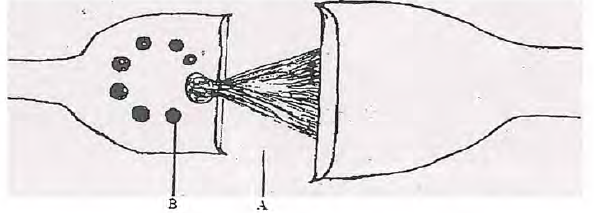- Define the following branches of Biology. (2 marks)
- Genetics
- Entomology
- State three reasons that necessitate classification of living organisms by taxonomists. (3 marks)
- Define resolving power of a microscope. (1 mark)
- State two functions played by the cell wall in plant cells and give the adaptation of the cell wall to performing each of the stated functions. (4 marks)
- The cells of a certain herbaceous plant were found to have a diameter of 25 μm. The cells were placed in varying concentrations of sugar solution. The average diameter of the cells in each solution was determined and the results obtained were as shown in the table below.
Concentration of sugar
Solution (%)Diameter of cells (μm) 1 50 5 40 10 30 15 20 - From the results determine the concentration of the cell sap. (1 mark)
- Give an explanation of the average diameter of the cells placed in 15% sugar solution. (3 marks)
- Name the process that occured in the cells which were placed in 1% sugar solution. (1 mark)
- Name two defects of the circulatory system in humans. (2 marks)
- State three functions of blood other than transport. (3 marks)
- The following specimens were extracted from a newly discovered organism.
- Name the tooth labelled M. (1 mark)
- Name the part labelled Q and state its role. (2 marks)
- The diagram below represents a cell organelle.
- Name the part labelled Y. (1 mark)
- State the function of the part labelled X. (1 mark)
- In what form is energy stored in muscles? (1 mark)
- State the economic importance of anaerobic respiration in plants. (2 marks)
- Name two gaseous exchange surfaces in plants. (2 marks)
- How are gaseous exchange surfaces in animals adapted to performing their function? (2 marks)
- What is the importance of counter flow system in fish? (2 marks)
- State two structural modifications of the kidneys of desert animals like the kangaroo rat. (2 marks)
- Name the fluid that is produced by sebaceous glands. (1 mark)
- What is the role of sweat on the human skin? (2 marks)
- The diagram below represents a certain plant species.
- State the class to which the plant belongs. (1 mark)
- State the difference between members of Gymnospermaphyta and Angiospermaphyta (2 marks)
- Give two reasons why a spider is classified under Phylum Arthropoda. (2 marks)
- Define the following terms as used in ecology.
- Population
- Autecology
- Form three students wanted to estimate the population of grasshoppers in 5 km2 grass field near a school compound. They captured 36 grasshoppers and marked them before returning them back to the field. After two days they made another catch of grasshoppers. They collected 45 grasshoppers of which only 4 had marks.
- State why the second capture was done after two days. (1 mark)
- From the data, calculate the population size of grasshoppers in the grass field. (2 marks)
- Define the following terms as used in ecology.
- In mitosis in animals chromatids failed to separate and move to opposite poles.
- Name the organelle that the cell was lacking. (1 mark)
- Name two regions in plants where cells actively undergo mitosis. (2 marks)
- The diagram below represents a transverse section of an ovary from a certain flower.
- Name the structure labelled A. (1 mark)
- Name the type of plancentation illustrated in this diagram. (1 mark)
- State the functions of the following parts. (2 marks)
- Endometrium
- Epididymis
- What mechanism facilitates the movement of the ovum towards the uterus? (1 mark)
- State the functions of the following parts. (2 marks)
- Use the diagram below to answer questions that follow.
- Identify the type of growth curve shown. (1 mark)
- State one factor that leads to phase labelled B. (1 mark)
- Give two differences between epigeal and hypogeal germination. (2 marks)
- State the function of juvenile hormone in growth and development of insects. (1 mark)
- What is sex linkage? (1 mark)
- Give two sex linked genes found on the Y chromosome. (2 marks)
- Below is a nucleotide strand
A G T C - Identify the type of nucleic acid. (1 mark)
- Give a reason for your answer in (a) above. (1 mark)
- What are analogous structures? (1 mark)
- Give one example of analogous structures. (1 mark)
- State comparative embryology as an evidence of organic evolution. (2 marks)
- State two structural differences between apes and human beings. (2 marks)
- The diagram below represents parts of a synapse.
- Name the part labelled A. (1 mark)
- What is the function of part labelled B. (1 mark)
- On the diagram show the direction of flow of impulse. (1 mark)
- State the function of cerebrospinal fluid. (1 mark)
- How is the choroid of the eye adapted to its function? (1 mark)
- Name a support tissue in plants that is not thickened. (1 mark)
- State the type of skeleton found in all vertebrates. (1 mark)
Join our whatsapp group for latest updates
Tap Here to Download for 50/-
Get on WhatsApp for 50/-
Download Bunyore Maranda MOCKS 2016 Biology Paper 1.
Tap Here to Download for 50/-
Get on WhatsApp for 50/-
Why download?
- ✔ To read offline at any time.
- ✔ To Print at your convenience
- ✔ Share Easily with Friends / Students

